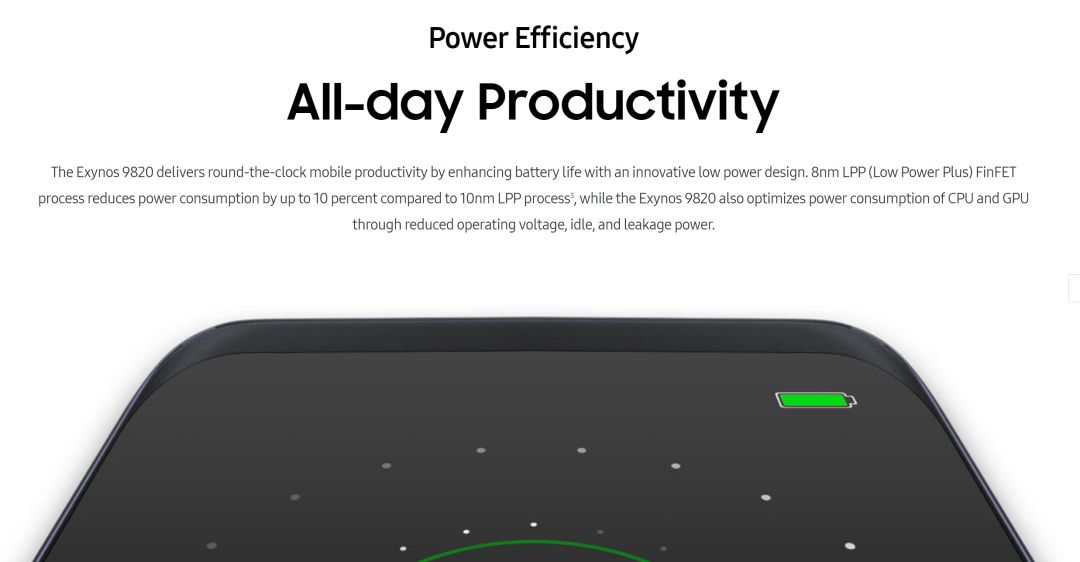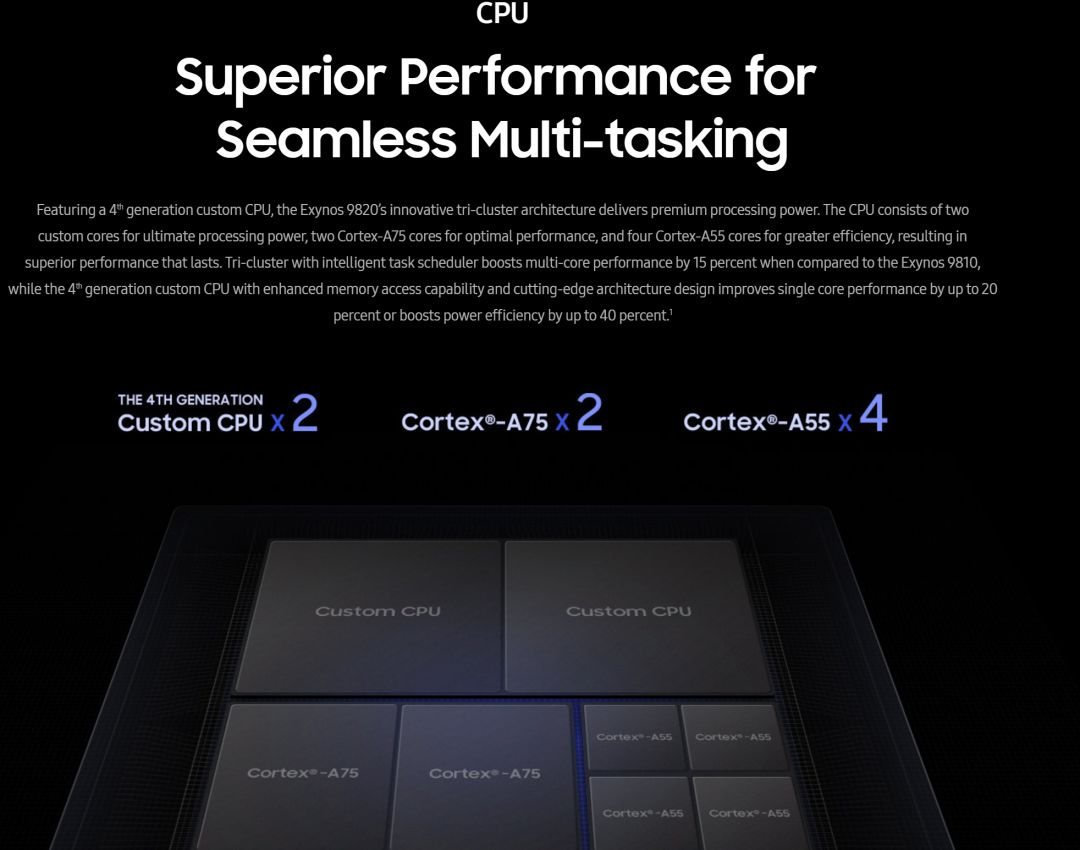
On November 14, Beijing time, Samsung officially launched its next-generation flagship mobile platform, the Exynos 9820. As the name suggests, it is an iterative version of the previous Exynos 9810, and it is expected that some versions of next year’s Galaxy S10 and Note10 will be equipped with this chip.
How powerful is the Samsung Exynos 9820? We bring you an in-depth analysis of this Android powerhouse.

New 8nm Process, Slightly Disappointing Not to See 7nm EUV
The Samsung Exynos 9820 is manufactured using Samsung’s 8nm LPP FinFET process, which further reduces power consumption compared to the previous Exynos 9810’s 10nm LPP process.

According to previous official introductions, Samsung’s 8nm LPP process reduces power consumption by about 10% compared to the 10nm LPP process. However, from the previously leaked process structure comparison, there are still some differences between the two.

However, when comparing the improvements of Samsung’s 10nm LPP over 10nm LPE, the 8nm LPP process seems less impressive. It is known that Samsung’s 10nm LPP reduced power consumption by 15% compared to 10nm LPE, while 8nm LPP only reduced it by 10% compared to 10nm LPP.
The main reason is that Samsung’s 8nm LPP process is actually a transitional process between 10nm LPP and 7nm LPP EUV. Therefore, in terms of performance improvement and power consumption reduction, it will definitely have some gap compared to 7nm LPP.
Why didn’t Samsung go directly to the 7nm LPP process? It is speculated that it is related to issues encountered in mass production of this technology. Currently, Apple’s A12 and Huawei’s Kirin 980 use TSMC’s 7nm process, and Qualcomm’s Snapdragon 8150 has not yet been released, but if it is still manufactured by Samsung, it is expected to adopt this process as well.
Fourth Generation Semi-Custom Cores + NPU Support, Strong Performance
The Samsung Exynos 9820 adopts a tri-cluster architecture, consisting of two fourth-generation self-developed cores, two Cortex-A75, and four Cortex-A55, which are responsible for extreme performance, sustained performance, and power-saving operations, with frequencies currently unspecified.
According to official information, Samsung’s fourth-generation self-developed cores have improved single-core performance by about 20%, with efficiency increased by 40%; multi-core performance has improved by about 15%.

In terms of CPU, the structure of the Samsung Exynos 9820 is similar to that of the Kirin 980, both using a tri-cluster architecture. Its advantage lies in the more powerful self-developed cores, but it should be noted that Samsung did not use the latest Cortex-A76, perhaps due to concerns about power consumption. Actual performance will need to be tested to know for sure.
At the same time, the Samsung Exynos 9820 integrates an artificial intelligence processor (NPU) for the first time, which is also a trend in the industry. By introducing the NPU, the Exynos 9820 will provide a better experience in areas such as AR.

Integrating Mali-G76 MP12 GPU, Self-Developed GPU Still in Progress

The Samsung Exynos 9820 integrates the ARM Mali-G76 MP12 GPU, which has two more cores than the Kirin 980’s Mali-G76 MP10. Although specific frequency data is not currently available, it seems that Samsung still intends to follow a multi-core low-frequency approach.
It is said that the ARM Mali-G76 MP12 GPU can provide a 40% performance increase and reduce power consumption by 35%. Therefore, it is definitely an improvement compared to the Mali-G72 MP18 integrated in the previous Exynos 9810.
However, it is somewhat regrettable that the previously leaked Samsung self-developed S-GPU still seems to be in progress, and it is estimated that it will take some time before it is released.

Baseband and Video Recording Become Key Highlights, Breaking Industry Records
From a parameter perspective, the main highlights of the Samsung Exynos 9820 are concentrated in the baseband and video recording.
First, in terms of baseband, the Samsung Exynos 9820 has an integrated LTE-Advanced Pro, supporting a peak downlink speed of 2.0Gbps, 8CA (Carrier Aggregation), and a peak uplink speed of 316Mbps. It also supports 4×4 MIMO, 256-QAM schemes, and enhanced licensed-assisted access (eLAA) technology.

It is worth mentioning that the LTE Cat.21 baseband integrated in Huawei’s Kirin 980 has a peak downlink speed of 1.4Gbps and a peak uplink speed of 200Mbps.
Samsung provided an example: at a downlink speed of 2.0Gbps, it takes about 15 seconds to download a 1080P HD movie (3.7GB in size), and it supports extremely low latency for running large multiplayer online games.
In terms of video recording, the Samsung Exynos 9820 can support video recording at up to 8K 30fps, which is quite rare in the current mobile chip industry. Additionally, it supports ultra-high frame rate 4K video recording at 150fps.

It must be said that for users who need to record ultra-high-definition videos, the Exynos 9820 is quite attractive. If this feature can be retained in products such as the Samsung S10 and Note10, it is expected to become a key selling point that distinguishes it from other competitors.
Finally, it is worth mentioning that the Samsung Exynos 9820 also integrates a more advanced ISP (Image Signal Processor), which can support up to five sensors. It supports a rear 22MP, front 22MP, or dual camera setup of 16MP + 16MP.

Of course, the Exynos 9820 also has some highlights, such as ensuring security through PUF (Physical Unclonable Function), supporting UFS 3.0 high-speed flash storage, and WQUXGA (3840×2400), 4K UHD (4096×2160) displays.
With such a Samsung Exynos 9820, how do you think it will fare against Qualcomm and Huawei?

November 28
ZEALER NEXT Launch EventSee you there
Don’t miss it
